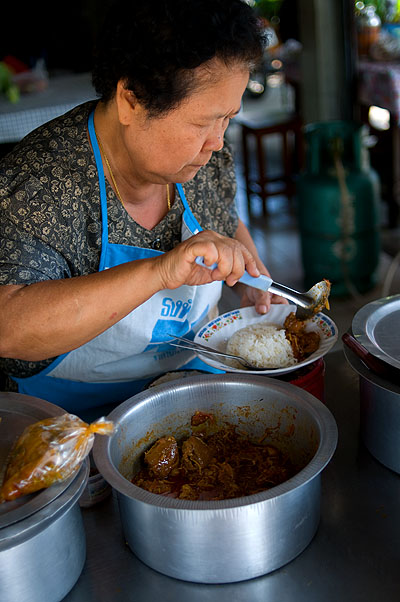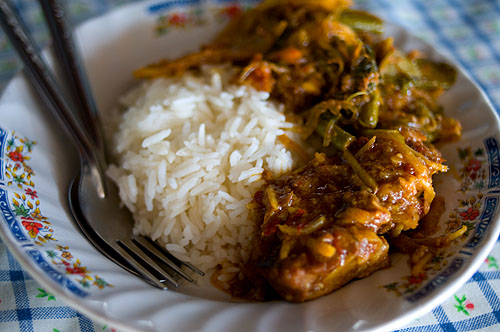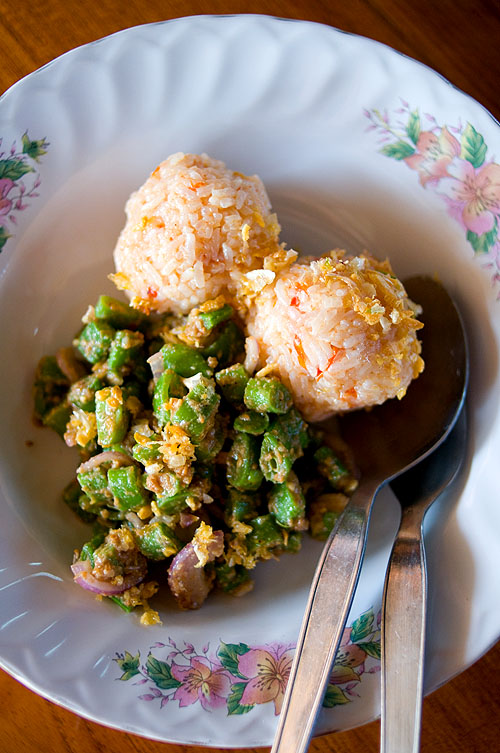 I’m in very good culinary company here in Mae Hong Son. As soon the owner of the house I’m renting learned that I have an interest in the local food, she started bringing me local sweets and snacks on a daily basis. This morning she went out of her way to bring me a local dish of sticky rice steamed with coconut milk and turmeric and served with local-style meatballs (more on this later), something that I had mentioned the previous day. My next-door neighbour, Phii Laa, is equally generous, and possibly even more enthusiastic. Once she learned that I was interested in the local eats she’s been in my kitchen every morning since, sharing a new recipe.
I’m in very good culinary company here in Mae Hong Son. As soon the owner of the house I’m renting learned that I have an interest in the local food, she started bringing me local sweets and snacks on a daily basis. This morning she went out of her way to bring me a local dish of sticky rice steamed with coconut milk and turmeric and served with local-style meatballs (more on this later), something that I had mentioned the previous day. My next-door neighbour, Phii Laa, is equally generous, and possibly even more enthusiastic. Once she learned that I was interested in the local eats she’s been in my kitchen every morning since, sharing a new recipe.
The first recipe Phii Laa shared is one I only came across recently. Khao som literally means ‘sour rice’, and is local a dish of balls of rice made sour by the addition of tomato and tamarind. The dish is traditionally served with yam thua, ‘bean salad’, the recipe for which can also be adapted to make any sort of local salad where the main ingredient, which here can range from tender fern shoots (a popular local ingredient) to sour leaves, is first par-boiled. In my next blog I’ll demonstrate how to make a saa, another type of local salad centred around fresh (as opposed to par-boiled) greens or veggies.
The ingredients required for khao som and yam thua are pretty basic and I imagine all are generally available even in the west, except for nam phrik phong:
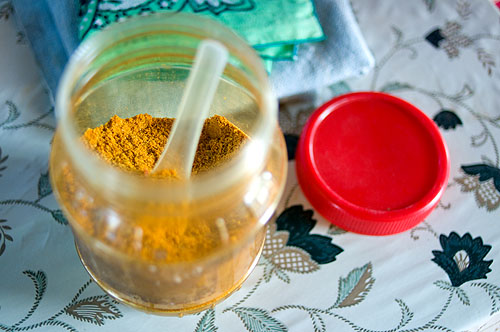
a mixture of thua nao (disks of dried soybean), dried chili, salt and MSG, all ground to a fine powder. If you’re determined, I’d suggest just substituting a pinch of finely ground dried chili flakes and some salt, although the dish will be missing a truly local flavour in thua nao.
And if you haven’t done it before, making crispy deep-fried garlic and garlic oil is a snap:
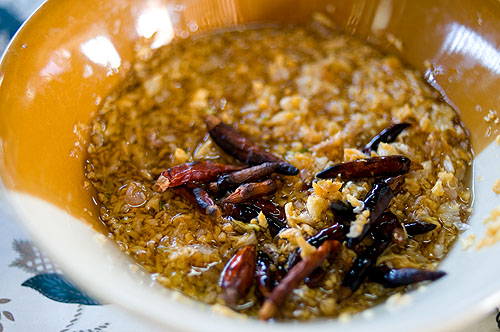
Simply get your hands the smallest cloves of garlic you can find, chop them up coarsely (skin and all), and simmer in a generous amount of oil over medium heat until the garlic is just beginning to become crispy. When this happens remove mixture to a heatproof container and allow to cool.
And as always, ingredient measurements below are estimated; Phii Laa, like most Thai cooks, doesn’t use measuring utensils, instead cooking by taste and feel.
Khao som & yam thua (Sour Shan-style rice and bean salad)
Uncooked rice, 2 cups
Strained tamarind pulp, 1 cup
Chopped tomatoes, 2 cups
Salt, 1 tsp
Turmeric powder, ½ tsp
Sugar, 1 Tbsp
French beans
Shrimp paste, 1 Tbsp
Nam phrik phong, 2 Tbsps
Ground roasted white sesame seeds, 4 Tbsp
Shallots, sliced, 4
Garlic oil & crispy deep-fried garlic
Deep-fried dried chilies
Cook rice with at least three cups of water (the rice is supposed to have a soft consistency). When cooked, allow to cool slightly.
Combine tamarind pulp, tomatoes, salt, turmeric and sugar in a wok over low heat. Simmer, stirring occasionally, until reduced to a thick paste:
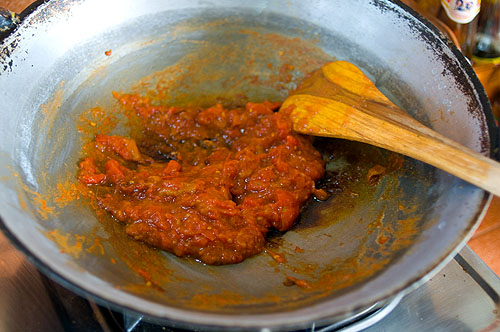
about 10 minutes. Set aside.
Prepare beans by removing the strings and chopping:
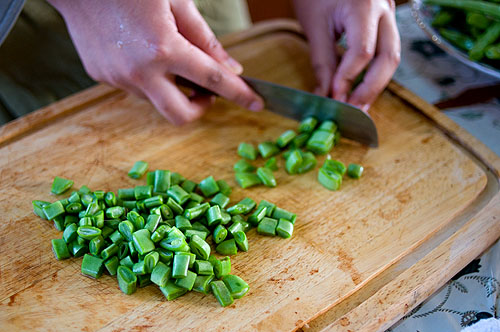
Par-boil beans until just cooked, about a minute, and shock in cold water. Set aside.
In a wok over medium heat, dissolve shrimp paste in ¼ cup of water. When shrimp paste is fully incorporated, add nam phrik phong and sesame. Combine thoroughly and turn off heat. Allow to cool slightly, add sliced shallots and beans and mix thoroughly. Remove to a serving dish and top with crispy fried garlic and garlic oil.
When rice is cool enough to handle, combine ¾ of the tamarind mixture with cooked rice.
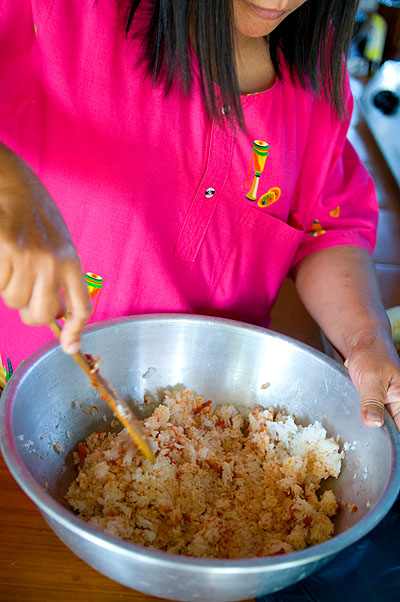
Taste and season with remaining tamarind mixture and/or salt if necessary.
Coating hands in a bit of the garlic oil, shape rice mixture into golf ball-sized balls:
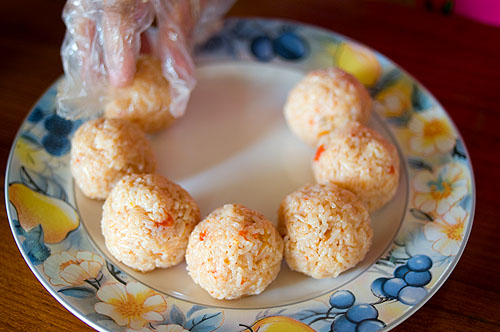
Arrange on a plate and drizzle with plenty of crispy garlic, oil and deep-fried chilies.

Serve dish, as illustrated at the top of this post, on individual plates with a generous serving of the bean salad.
 This morning I took a drive along Hwy 1285, an isolated road that twists 15km between mountain valleys to the village of Huay Phueng, not far from the Burmese border. It's getting warmer in Mae Hong Son, but driving a motorcycle at 7am, in the shadows of the hills, it was so cold I quickly lost the feeling in my hands.
This morning I took a drive along Hwy 1285, an isolated road that twists 15km between mountain valleys to the village of Huay Phueng, not far from the Burmese border. It's getting warmer in Mae Hong Son, but driving a motorcycle at 7am, in the shadows of the hills, it was so cold I quickly lost the feeling in my hands.














 Jin lung are a local type of meatball, rich in fresh herbs and often yellow in colour from the addition of dried turmeric powder. They're most commonly made from pork, but beef and fish versions can be found on occasion. In Mae Hong Son's morning market they're sold in Indian-style pots in a generous amount of the yellow cooking oil, and when ordered, two or four (the serving sizes here are really small) are bagged up with a drizzle of the oil and some deep-fried crispy garlic.
Jin lung are a local type of meatball, rich in fresh herbs and often yellow in colour from the addition of dried turmeric powder. They're most commonly made from pork, but beef and fish versions can be found on occasion. In Mae Hong Son's morning market they're sold in Indian-style pots in a generous amount of the yellow cooking oil, and when ordered, two or four (the serving sizes here are really small) are bagged up with a drizzle of the oil and some deep-fried crispy garlic.



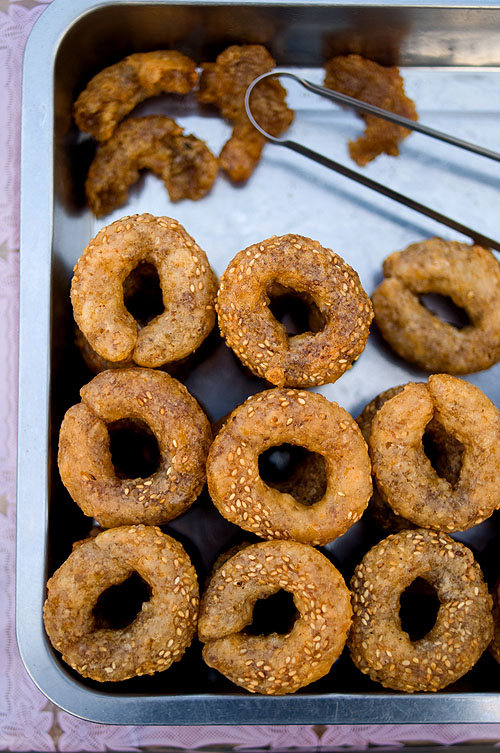 The bloggers at EatingAsia recently pointed out that
The bloggers at EatingAsia recently pointed out that 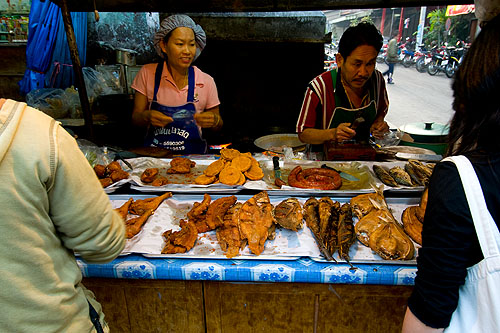
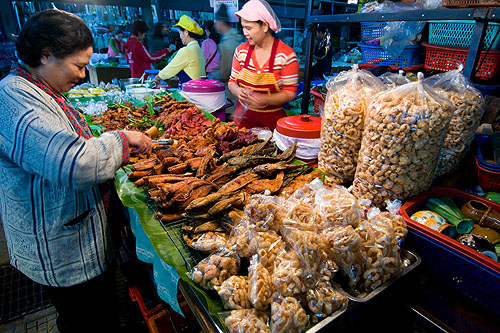
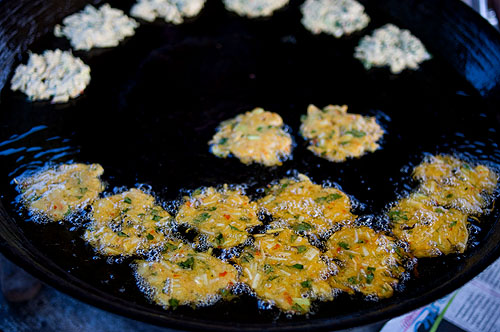
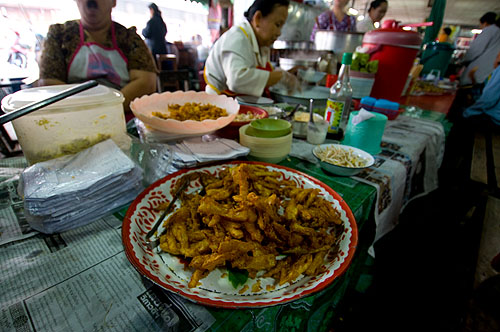
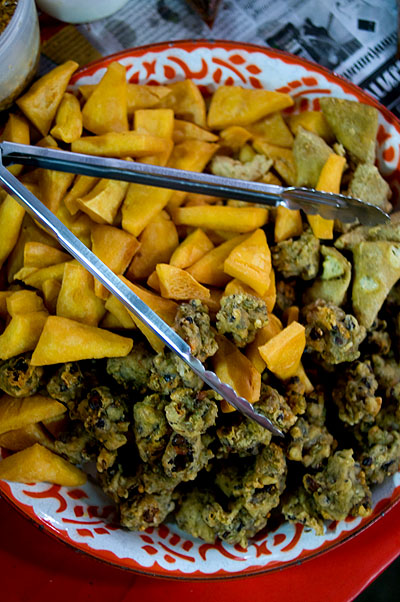
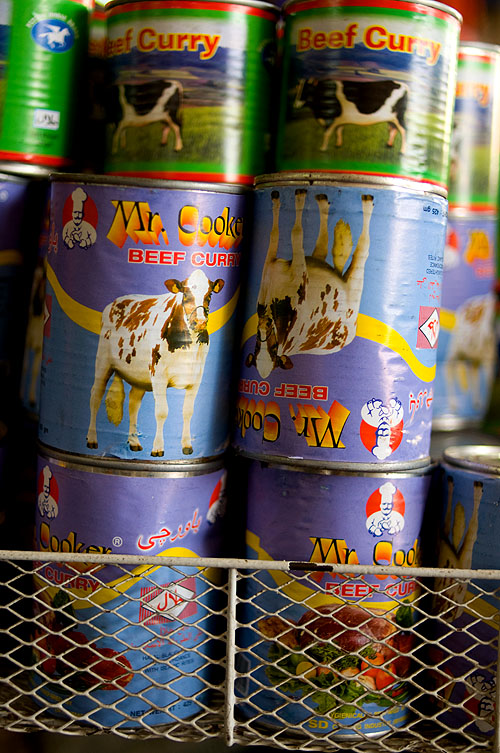 but I think I might have to draw the line at Mr Cooker brand tinned beef curry from Myanmar.
but I think I might have to draw the line at Mr Cooker brand tinned beef curry from Myanmar. A vendor of Burmese goods at the town's morning market
A vendor of Burmese goods at the town's morning market 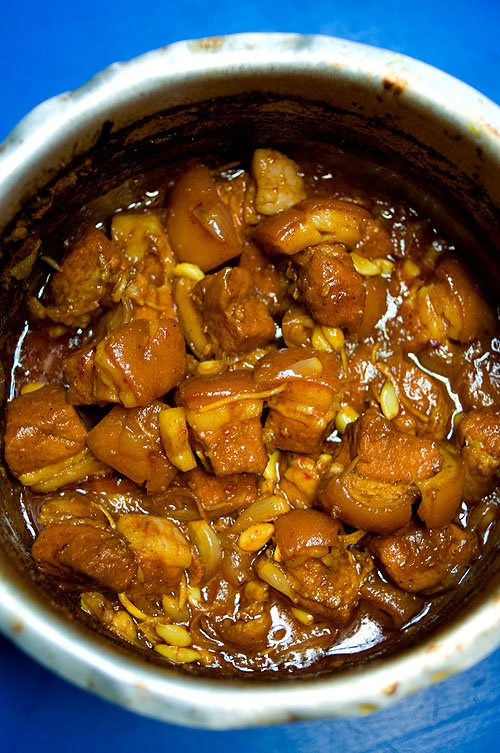 Khun Yay (‘Grandma’), my landlord’s mother, is originally from Ayuthaya, but moved to Mae Hong Son when she was 14 – more than 70 years ago. 'It took us three months to walk here from Ayuthaya,' she explained to me, adding that part of the journey was done on elephant back. After seven decades here she’s essentially a native of the city, and even used to earn extra money by selling Thai Yai/Shan sweets. She can also make the local savoury dishes, and everybody in the family agrees that she makes a mean hang lay.
Khun Yay (‘Grandma’), my landlord’s mother, is originally from Ayuthaya, but moved to Mae Hong Son when she was 14 – more than 70 years ago. 'It took us three months to walk here from Ayuthaya,' she explained to me, adding that part of the journey was done on elephant back. After seven decades here she’s essentially a native of the city, and even used to earn extra money by selling Thai Yai/Shan sweets. She can also make the local savoury dishes, and everybody in the family agrees that she makes a mean hang lay.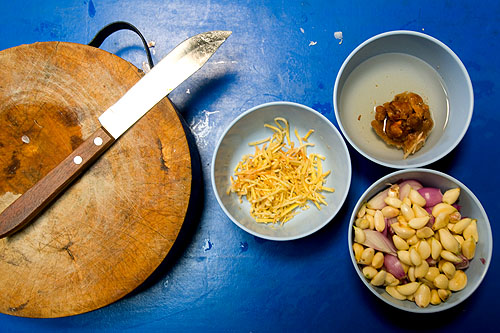
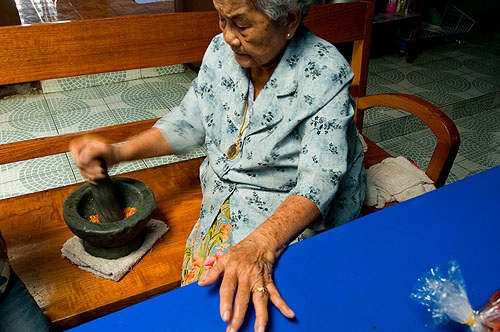
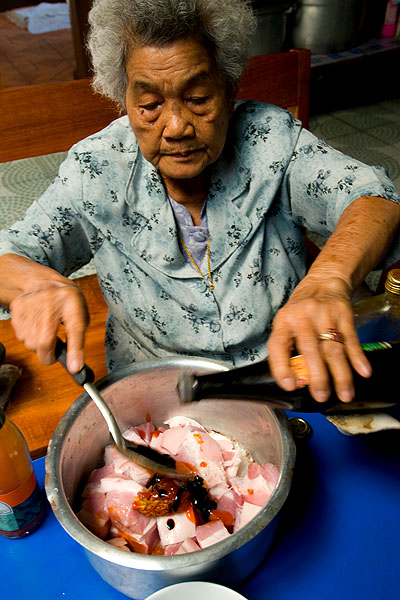

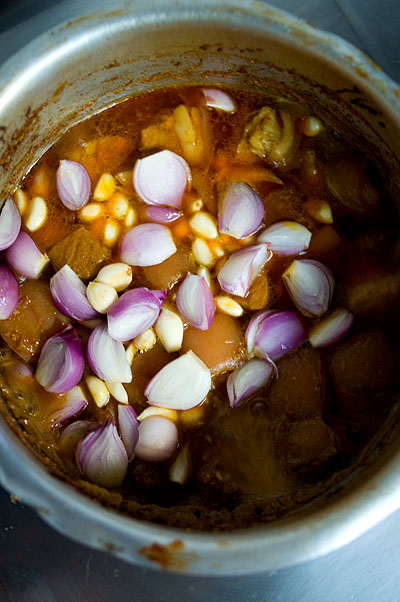
 Yesterday, Phii Laa, my neighbour, came over with the tray of ingredients pictured above and a desire to share her recipe for saa, a local type of yam or Thai-style ‘salad’. I was excited about this because in Mae Hong Son there are several variations on the standard Thai yam that I've yet to get my head around: there’s the type I mentioned in the
Yesterday, Phii Laa, my neighbour, came over with the tray of ingredients pictured above and a desire to share her recipe for saa, a local type of yam or Thai-style ‘salad’. I was excited about this because in Mae Hong Son there are several variations on the standard Thai yam that I've yet to get my head around: there’s the type I mentioned in the 


 I’m in very good culinary company here in Mae Hong Son. As soon the owner of the house I’m renting learned that I have an interest in the local food, she started bringing me local sweets and snacks on a daily basis. This morning she went out of her way to bring me a local dish of sticky rice steamed with coconut milk and turmeric and served with local-style meatballs (more on this later), something that I had mentioned the previous day. My next-door neighbour, Phii Laa, is equally generous, and possibly even more enthusiastic. Once she learned that I was interested in the local eats she’s been in my kitchen every morning since, sharing a new recipe.
I’m in very good culinary company here in Mae Hong Son. As soon the owner of the house I’m renting learned that I have an interest in the local food, she started bringing me local sweets and snacks on a daily basis. This morning she went out of her way to bring me a local dish of sticky rice steamed with coconut milk and turmeric and served with local-style meatballs (more on this later), something that I had mentioned the previous day. My next-door neighbour, Phii Laa, is equally generous, and possibly even more enthusiastic. Once she learned that I was interested in the local eats she’s been in my kitchen every morning since, sharing a new recipe.






 Khao ya koo is the Shan/Thai Yai name for a type of sweetened sticky rice. Other than simply being a sweet snack, the dish has strong associations with celebration, as it's only made on certain holidays. It also has ties with community, and as you'll see, is one distinctly local method of making merit (kwaa loo in the local dialect).
Khao ya koo is the Shan/Thai Yai name for a type of sweetened sticky rice. Other than simply being a sweet snack, the dish has strong associations with celebration, as it's only made on certain holidays. It also has ties with community, and as you'll see, is one distinctly local method of making merit (kwaa loo in the local dialect).










 This is a Thai Yai/Shan dish that one sees for sale all over Mae Hong Son, and it combines ingredients essential to virtually every local dish: soybeans (both in the form of tofu and thua nao, disks of dried soybeans), garlic, tomatoes and turmeric. However, just like any other dish, there appears to be several different ways to make thua phoo khua. My neighbour claims that thua nao has no place in the chili paste of this dish, and that she normally uses fresh chilies. The ladies selling meat in the morning market told me that I have to use thua nao and dried chilies... I've followed the latter method, combined with a recipe from a Thai-language cookbook printed in Mae Hong Son.
This is a Thai Yai/Shan dish that one sees for sale all over Mae Hong Son, and it combines ingredients essential to virtually every local dish: soybeans (both in the form of tofu and thua nao, disks of dried soybeans), garlic, tomatoes and turmeric. However, just like any other dish, there appears to be several different ways to make thua phoo khua. My neighbour claims that thua nao has no place in the chili paste of this dish, and that she normally uses fresh chilies. The ladies selling meat in the morning market told me that I have to use thua nao and dried chilies... I've followed the latter method, combined with a recipe from a Thai-language cookbook printed in Mae Hong Son.




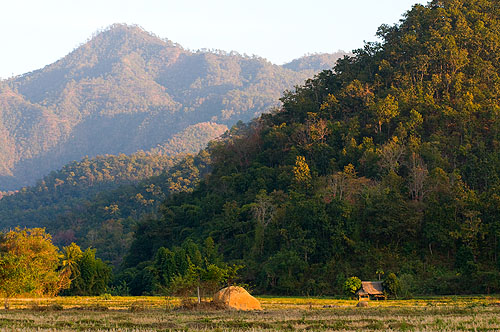
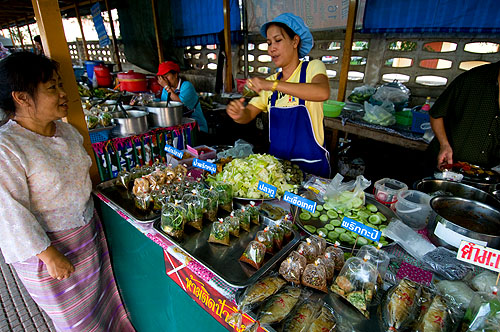
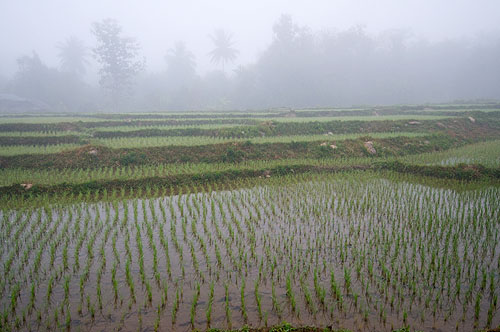
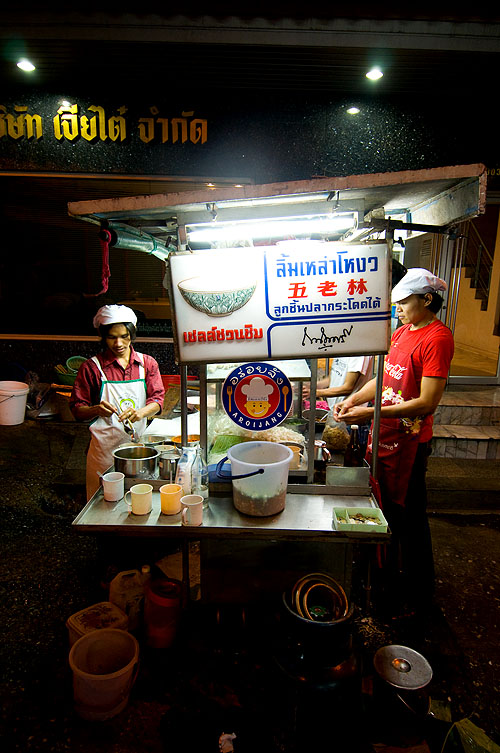 The tongue-twistingly difficult name of this street stall is Chinese in origin, appropriate for a stall on the outer edges of Bangkok’s Chinatown. I was escorted there by David Thompson, who knows the neighbourhood a lot better than I’d expected.
The tongue-twistingly difficult name of this street stall is Chinese in origin, appropriate for a stall on the outer edges of Bangkok’s Chinatown. I was escorted there by David Thompson, who knows the neighbourhood a lot better than I’d expected.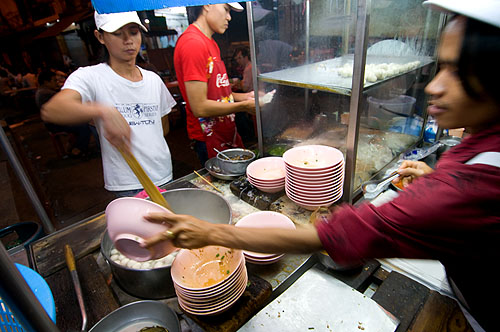
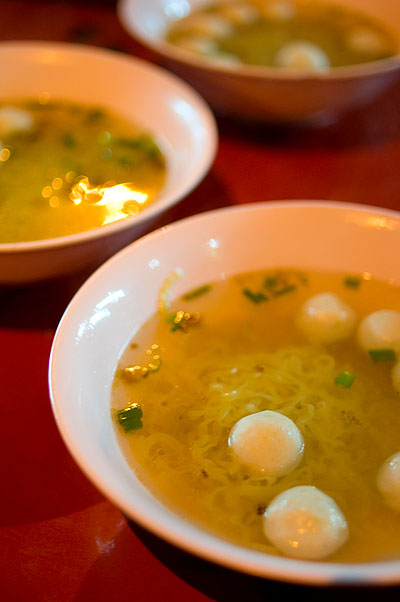
 The title of this post is a take on the oft-cited 2005
The title of this post is a take on the oft-cited 2005 





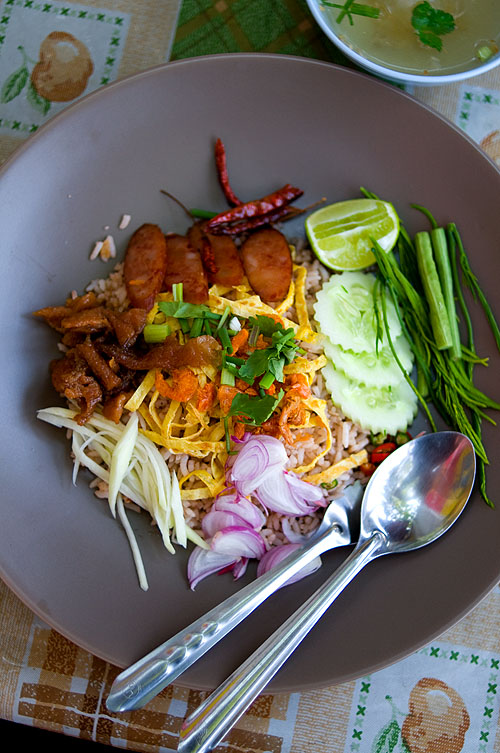 Lying just steps from the famous backpacker district of Th Khao San, you'd think that there would be much in the way of authentic Thai food on Th Phra Athit. But there are actually some pretty interesting places to eat. My most recent find is a tiny streetside stall that serves only three dishes, the most famous of which is khao khluk kapi, rice cooked with shrimp paste and served with a variety of delicious toppings -- a dish mentioned
Lying just steps from the famous backpacker district of Th Khao San, you'd think that there would be much in the way of authentic Thai food on Th Phra Athit. But there are actually some pretty interesting places to eat. My most recent find is a tiny streetside stall that serves only three dishes, the most famous of which is khao khluk kapi, rice cooked with shrimp paste and served with a variety of delicious toppings -- a dish mentioned 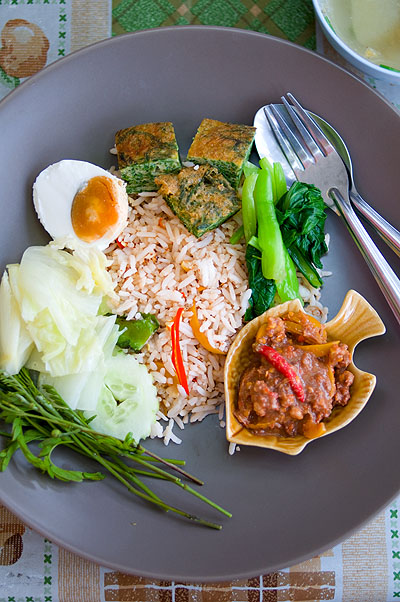
 Lephet thoke is a popular Burmese dish based around pickled tea leaves. The sour, slightly bitter leaves are mixed with shredded cabbage, sliced tomatoes, crunchy deep-fried beans, nuts and peas, a splash of oil and pungent slices of chili and garlic. The dish is versatile: it can be a snack, an appetiser or a palate cleanser. Allegedly it's also a stimulant; a Burmese waiter in Mae Sot, Thailand, told me that I'd be up all night if I ate too much lephet thoke.
Lephet thoke is a popular Burmese dish based around pickled tea leaves. The sour, slightly bitter leaves are mixed with shredded cabbage, sliced tomatoes, crunchy deep-fried beans, nuts and peas, a splash of oil and pungent slices of chili and garlic. The dish is versatile: it can be a snack, an appetiser or a palate cleanser. Allegedly it's also a stimulant; a Burmese waiter in Mae Sot, Thailand, told me that I'd be up all night if I ate too much lephet thoke.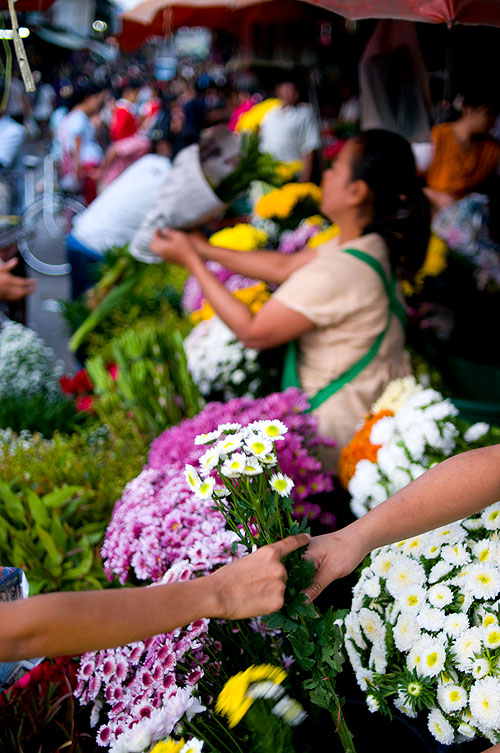 At Mae Sot's morning market, Tak
At Mae Sot's morning market, Tak 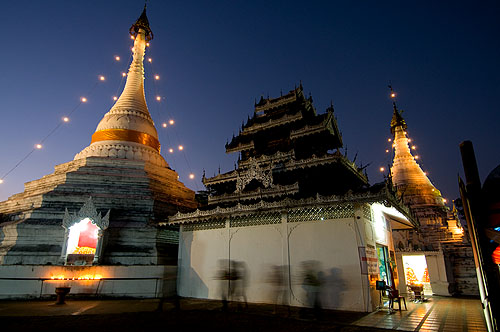
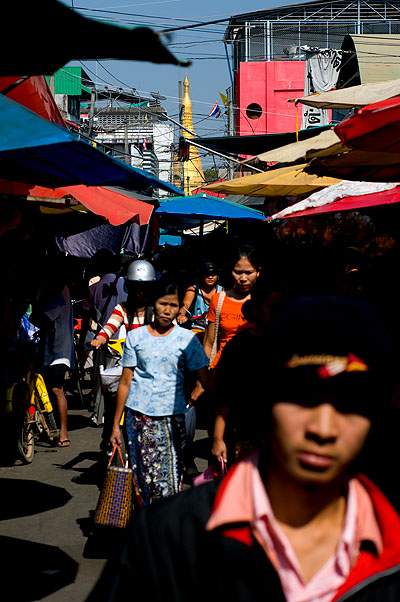

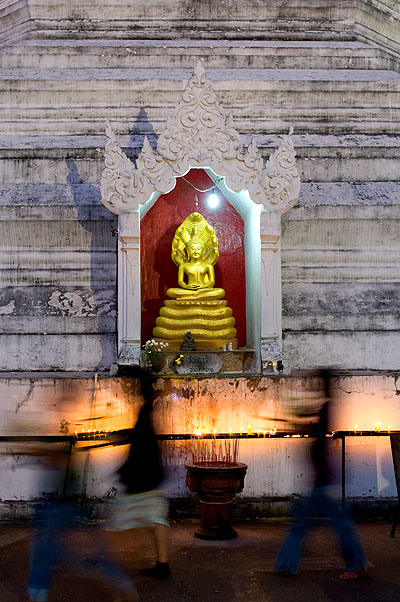
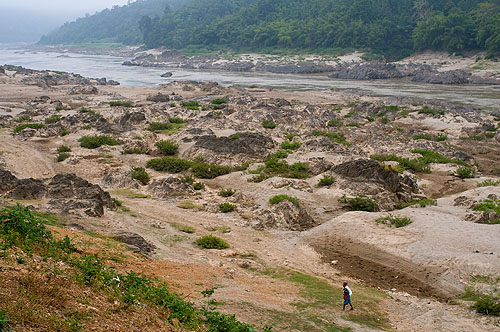
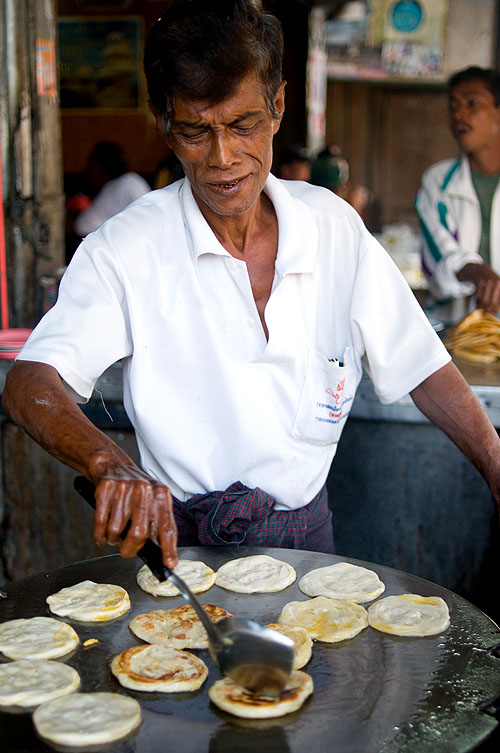 Mae Sot, a bustling city near the Burmese border in Tak province is mostly populated by Burmese refugees. Many of those who live in town are Muslim, and have had a huge influence on the city's food scene. In particular, along the street that runs south of the city's main mosque, you'll find several Burmese/Muslim-owned teashops:
Mae Sot, a bustling city near the Burmese border in Tak province is mostly populated by Burmese refugees. Many of those who live in town are Muslim, and have had a huge influence on the city's food scene. In particular, along the street that runs south of the city's main mosque, you'll find several Burmese/Muslim-owned teashops: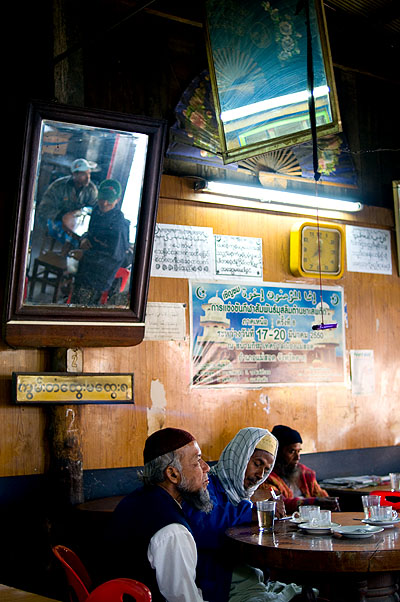
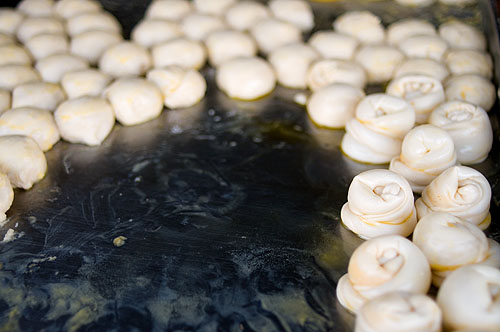
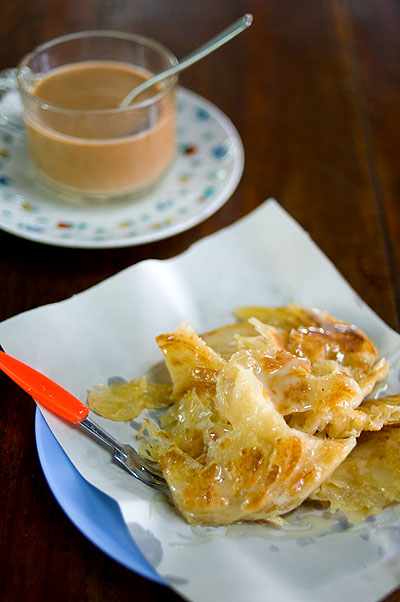
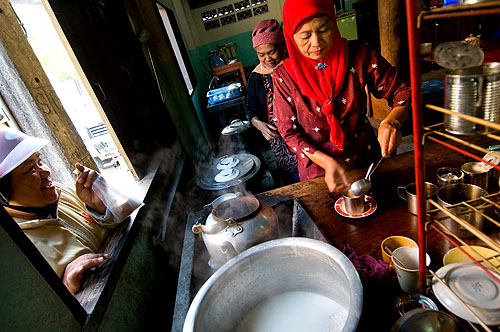
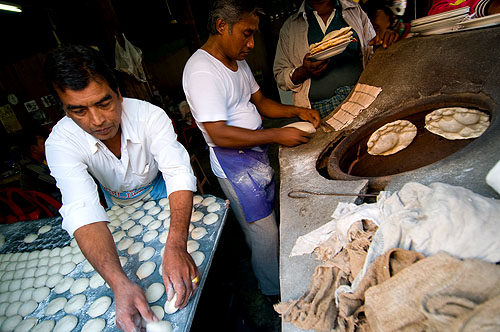
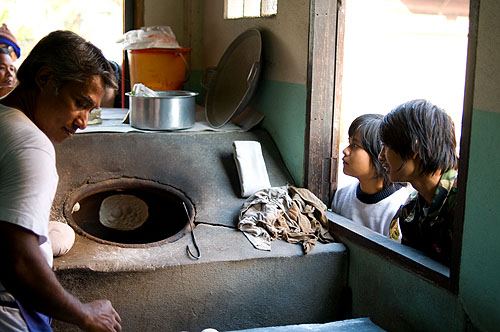
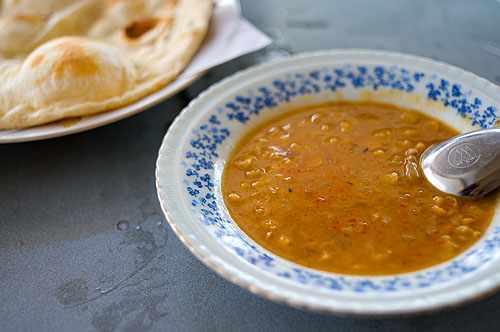
 The name of this dish is, I believe, dialect for, 'rice with meat'. It's a Shan dish that one finds all over northern Thailand, but is best near its traditional homeland.
The name of this dish is, I believe, dialect for, 'rice with meat'. It's a Shan dish that one finds all over northern Thailand, but is best near its traditional homeland.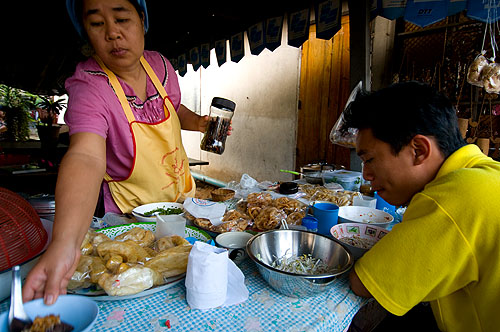
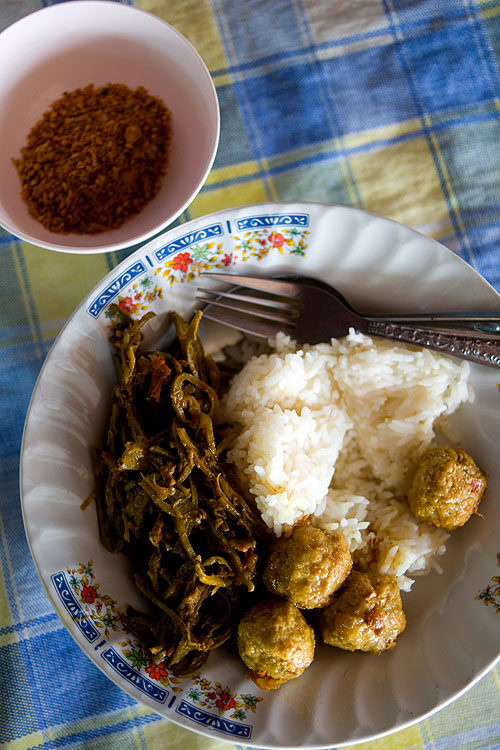 Mae Sri Bua is a Shan restaurant in Mae Hong Son. The owner/chef, Mae Sri Bua is a native of the city and has been at this a long time. She has trouble walking nowadays, but still manages to make some pretty good eats.
Mae Sri Bua is a Shan restaurant in Mae Hong Son. The owner/chef, Mae Sri Bua is a native of the city and has been at this a long time. She has trouble walking nowadays, but still manages to make some pretty good eats.